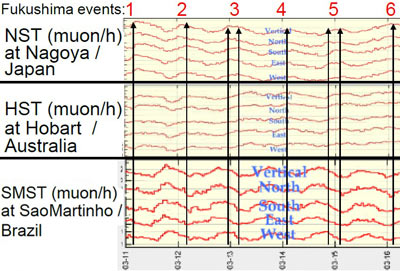
AP Photographer: I could fell a “buzzing” in air when in Fukushima, how do you show that in a picture? — Gov’t Experts: Fukushima radiation affected telescopes used to detect space weather; Thought to be related to decay of plutonium (VIDEO)
ENE News

cosmic ray positrons and Z0 additional μ- μ+… Therefore, the time correspondence of the comic ray variations observed at Nagoya muon telescope with the Tohuku earthquake respectively Fukushima Dai-ichi nuclear power plant failure requires further investigations before the causal conclusion can be deduced…
Jansen et al., Space Weather Workshop 2012, NOAA Space Weather Prediction Center: Observations: between 11 to 16 March 2011 only 1 of 5 GMDN [Global Muon Detector Network] telescopes measured increase in CR muon counts => this is the Nagoya Scintallator Telescope (NST has about 600 km distance from Fukushima-Daiichi (FD) nuclear power station (NPS))… Hints for correlations in time between Fukushima events and Nagoya muon measurements… No correlations in time between Fukushima events and Hobart /SaoMartinho [Australia and Brazil]… Big question: physics behind additional NST μ‘s from FD NPS? … explosions / ventings: ΔIμ ~ 1-2% (NST cosmic ray muon anisotropy)… Hypothese about correlation of GMDN / NST and FD data
David Guttenfelder, Associated Press photographer, 2013: “You’re trying to show that the place is contaminated and radiation is invisible, so you had to rely on mood, you had to rely on — you felt like the place was buzzing when you were there, but how do you show that in a picture? That was a real challenge… Just an emptiness, and you’re feeling afraid and anxious and your radiation meter is beeping, and how do you show that in a picture… and make you feel like this is a poisoned place?”
Watch the interview with Guttenfelder here
Published: July 1st, 2015 at 10:21 pm ETBy ENENews |
